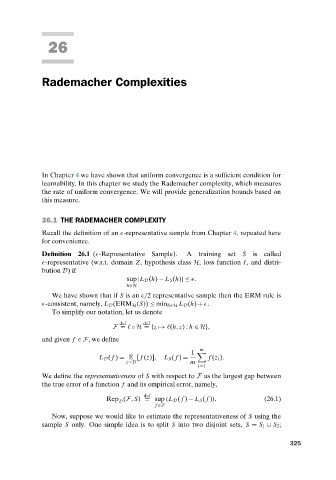Page 343 - Understanding Machine Learning
P. 343
26
Rademacher Complexities
In Chapter 4 we have shown that uniform convergence is a sufficient condition for
learnability. In this chapter we study the Rademacher complexity, which measures
the rate of uniform convergence. We will provide generalization bounds based on
this measure.
26.1 THE RADEMACHER COMPLEXITY
Recall the definition of an
-representative sample from Chapter 4, repeated here
for convenience.
Definition 26.1 (
-Representative Sample). A training set S is called
-representative (w.r.t. domain Z, hypothesis class H, loss function , and distri-
bution D)if
sup|L D (h) − L S (h)|≤
.
h∈H
We have shown that if S is an
/2 representative sample then the ERM rule is
-consistent, namely, L D (ERM H (S)) ≤ min h∈H L D (h) +
.
To simplify our notation, let us denote
def def
F = ◦ H ={z → (h,z): h ∈ H},
and given f ∈ F, we define
m
1
L D ( f ) = E [ f (z)], L S ( f ) = f (z i ).
z∼D m
i=1
We define the representativeness of S with respect to F as the largest gap between
the true error of a function f and its empirical error, namely,
def
Rep (F, S) = sup (L D ( f ) − L S ( f )). (26.1)
D
f ∈F
Now, suppose we would like to estimate the representativeness of S using the
sample S only. One simple idea is to split S into two disjoint sets, S = S 1 ∪ S 2 ;
325

